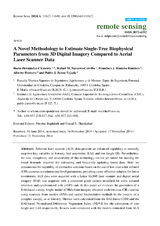Mostrar el registro sencillo del ítem
A Novel Methodology to Estimate Single-Tree Biophysical Parameters from 3D Digital Imagery Compared to Aerial Laser Scanner Data
| dc.contributor.author | Hernández Clemente, Rocío | |
| dc.contributor.author | Navarro Cerrillo, Rafael M. | |
| dc.contributor.author | Romero Ramírez, Francisco J. | |
| dc.contributor.author | Hornero, Alberto | |
| dc.contributor.author | Zarco-Tejada, Pablo J. | |
| dc.date.accessioned | 2017-11-07T10:54:33Z | |
| dc.date.available | 2017-11-07T10:54:33Z | |
| dc.date.issued | 2014 | |
| dc.identifier.uri | http://hdl.handle.net/10396/15335 | |
| dc.description.abstract | Airborne laser scanner (ALS) data provide an enhanced capability to remotely map two key variables in forestry: leaf area index (LAI) and tree height (H). Nevertheless, the cost, complexity and accessibility of this technology are not yet suited for meeting the broad demands required for estimating and frequently updating forest data. Here we demonstrate the capability of alternative solutions based on the use of low-cost color infrared (CIR) cameras to estimate tree-level parameters, providing a cost-effective solution for forest inventories. ALS data were acquired with a Leica ALS60 laser scanner and digital aerial imagery (DAI) was acquired with a consumer-grade camera modified for color infrared detection and synchronized with a GPS unit. In this paper we evaluate the generation of a DAI-based canopy height model (CHM) from imagery obtained with low-cost CIR cameras using structure from motion (SfM) and spatial interpolation methods in the context of a complex canopy, as in forestry. Metrics were calculated from the DAI-based CHM and the DAI-based Normalized Difference Vegetation Index (NDVI) for the estimation of tree height and LAI, respectively. Results were compared with the models estimated from ALS point cloud metrics. Field measurements of tree height and effective leaf area index (LAIe) were acquired from a total of 200 and 26 trees, respectively. Comparable accuracies were obtained in the tree height and LAI estimations using ALS and DAI data independently. Tree height estimated from DAI-based metrics (Percentile 90 (P90) and minimum height (MinH)) yielded a coefficient of determination (R2) = 0.71 and a root mean square error (RMSE) = 0.71 m while models derived from ALS-based metrics (P90) yielded an R2 = 0.80 and an RMSE = 0.55 m. The estimation of LAI from DAI-based NDVI using Percentile 99 (P99) yielded an R2 = 0.62 and an RMSE = 0.17 m2/m−2. A comparative analysis of LAI estimation using ALS-based metrics (laser penetration index (LPI), interquartile distance (IQ), and Percentile 30 (P30)) yielded an R2 = 0.75 and an RMSE = 0.14 m2/m−2. The results provide insight on the appropriateness of using cost-effective 3D photo-reconstruction methods for targeting single trees with irregular and heterogeneous tree crowns in complex open-canopy forests. It quantitatively demonstrates that low-cost CIR cameras can be used to estimate both single-tree height and LAI in forest inventories | es_ES |
| dc.format.mimetype | application/pdf | es_ES |
| dc.language.iso | eng | es_ES |
| dc.publisher | MDPI | es_ES |
| dc.rights | https://creativecommons.org/licenses/by/4.0/ | es_ES |
| dc.source | Remote Sensing 6(11), 11627-11648 (2014) | es_ES |
| dc.subject | Tree height | es_ES |
| dc.subject | LAI | es_ES |
| dc.subject | Low-cost camera | es_ES |
| dc.subject | 3D image modeling | es_ES |
| dc.subject | ALS data | es_ES |
| dc.subject | Oak forest | es_ES |
| dc.title | A Novel Methodology to Estimate Single-Tree Biophysical Parameters from 3D Digital Imagery Compared to Aerial Laser Scanner Data | es_ES |
| dc.type | info:eu-repo/semantics/article | es_ES |
| dc.relation.publisherversion | http://dx.doi.org/10.3390/rs61111627 | es_ES |
| dc.relation.projectID | info:eu-repo/grantAgreement/EC/FP7, 315165 (THERMOLIDAR) | es_ES |
| dc.relation.projectID | Gobierno de España. AGL2012-40053-C03-01 | es_ES |
| dc.rights.accessRights | info:eu-repo/semantics/openAccess | es_ES |

